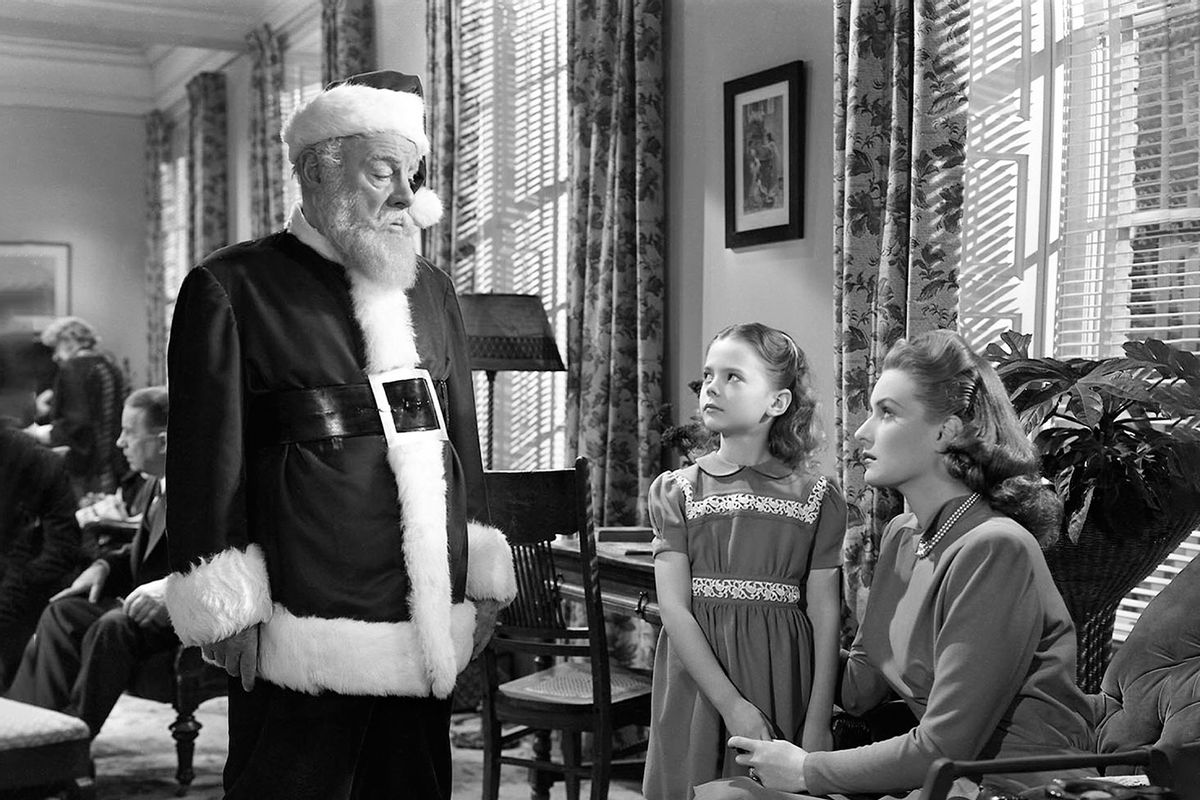
Over Friday and Saturday evenings we watched Miracle on 34th Street for the first time in a couple decades. (I’m not sure if Y had ever seen it.) After such time goes by, you see things in a film or book that you didn’t earlier.
I remembered the basic story about a department store Santa Claus who claims he really is Santa Claus, and how this plays out all the way to a court trial.
What I didn’t remember was a key point established early on. That the main character, a divorced woman who works for Macy’s Department Store (in New York City of course) is raising her daughter to be a strict realist. Not to believe in fairy tales, Santa Claus, or any such thing. The girl is firm in accepting this guidance. Yet as clues grow that Kris Kringle (played by Edmund Gwenn, whose role was for some reason designated “supporting” actor for the Oscars that year) really is Santa Claus, the girl’s skepticism is challenged, and her mother’s commitment wavers in the face of a charming man she likes and truly wants to help.
It was interesting to see how these themes played out, given of course how a Hollywood film of this era would *never* challenge anyone’s religious beliefs, or even the beliefs in Santa Claus of children who might be watching the film. So the film basically has it both ways. For legal purposes, the fact that the Post Office sends all mail addressed to Santa Claus to Kris Kringle at the courthouse is sufficient to settle the court case, even if all the adults in the room ridicule the notion of a real Santa Claus. (Of course, there are all sorts of reasonable questions that might have been brought up at a trial to determine if a claimant really is Santa Claus. Do you have evidence of a toy factory at the north pole? Can you explain how you deliver presents to millions of kids in one night? And so on. The film doesn’t go there. It doesn’t even wonder where Kris Kringle goes off to, on Christmas Eve day once the trial ends.)
Meanwhile the mother and her new boyfriend are so anxious to help Kris Kringle that mother encourages her daughter to believe in him, if only for his own sake, to have faith. Which the daughter tries to do, despite KK’s apparent failure to bring her family the house in the suburbs she’d always wanted. The ending has it both ways: the dream of the house was instilled by her mother via a real estate brochure, so it’s not a surprise that they find that very house on a drive the next day, Christmas Day. So that dream was contrived and Santa Claus failed? But wait — (spoiler) — there inside the otherwise empty house is… Kris Kringle’s cane!
So, reason to believe. Mother becomes convinced that belief and faith are necessary, even if all the evidence is against it. And that’s the conclusion most people reach, if they don’t calculate it out. Belief and faith in one story or another are important for human society, for community or national bonding. Adhering to strict realism doesn’t make you lots of friends.
Today there was this article —
Salon, Anna Thompson Hajdik, 25 Dec 2022: “Miracle on 34th Street” reminds us that home ownership was once an elusive dream for many Americans, subtitled “Revisiting this delightful holiday classic 75 years later reflects postwar anxieties that are still relevant today”
— that focuses on another key theme: why the idea of city folk (who live in apartments) finding a home to own for themselves was so important, especially in that era.
\\\
Last night, Christmas Eve, we watched another famous story set on Christmas Eve — Mr. Magoo’s Christmas Carol, the 1962 animated version I grew up watching, and have continued to watch at least every couple three years.
Triggering off something I read recently, new thoughts occurred to me this time round. Why was Scrooge so much meaner than his own boss, Fezziwig? The story’s answer is that Ebernezer led a lonely childhood. Or was it really, according to something I read recently (which of course now I can’t find), that this was an example of the growing effects of capitalism, the decrease of sympathy between the owners and workers. Then, why did Scrooge relent and become so nice at the end? The story’s answer is that he is so frightened by the vision of Tiny Tim’s death, and the prospect of his own death, revealed to him by the Ghost of Christmas Yet to Come, that he repents and become an enthusiastic philanthropist. Really? As a matter of character motivation, I don’t find that particularly convincing.
But upon some reflection, even as I wrote this post, I think both of these stories are examples of how one’s worldview can change when confronted with how an issue affects you or someone you personally know — e.g. the “persuasive interactions” in David McRaney’s HOW MINDS CHANGE. The adults in “Miracle” all know there’s no Santa Claus, but Mother decides to support Kris Kringle anyway, having met him and worried about what will happen to him. The personal trumps the intellectual. Scrooge knew intellectually about the poor-houses and the surplus population, but when a boy he knew (at least by association) died of neglect, indirectly his own, those issues became personal.
And that’s why stories of all kind are important, and work better than facts and statistics in how people view the world, and what they do about it.
I suppose literary/narrative/film scholars understand stories like these in much the same way, just using different terminology.
And that’s what I now take from “Miracle on 34th Street” and “A Christmas Carol.”





